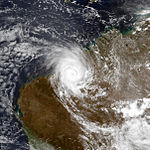1995–96 Australian region cyclone season
| 1995–96 Australian region cyclone season |

Season summary map
|
| Seasonal boundaries |
| First system formed |
16 November 1995 |
| Last system dissipated |
6 May 1995 |
| Strongest storm |
|
| Name |
Olivia |
| • Maximum winds |
195 km/h (120 mph)
(10-minute sustained) |
| • Lowest pressure |
925 hPa (mbar) |
|
| Seasonal statistics |
| Tropical lows |
19 |
| Tropical cyclones |
14 official, 1 unofficial |
| Severe tropical cyclones |
9 |
| Total fatalities |
1 direct |
| Total damage |
$58.5 million (1996 USD) |
| Related articles |
|
|
Australian region tropical cyclone seasons
1993–94, 1994–95, 1995–96, 1996–97, 1997–98
|
| Category 3 severe tropical cyclone (Australian scale) |
| Category 1 tropical cyclone (SSHWS) |
|
|
| Duration |
16 November – 19 November (Crossed basin)
|
| Peak intensity |
120 km/h (75 mph) (10-min) 965 hPa (mbar) |
| Category 1 tropical cyclone (Australian scale) |
| Tropical storm (SSHWS) |
|
|
| Duration |
2 December – 16 December |
| Peak intensity |
75 km/h (45 mph) (10-min) 990 hPa (mbar) |
| Category 3 severe tropical cyclone (Australian scale) |
| Category 4 tropical cyclone (SSHWS) |
|
|
| Duration |
6 December – 13 December |
| Peak intensity |
155 km/h (95 mph) (10-min) 950 hPa (mbar) |
| Category 3 severe tropical cyclone (Australian scale) |
| Category 1 tropical cyclone (SSHWS) |
|
|
| Duration |
17 December – 24 December |
| Peak intensity |
130 km/h (80 mph) (10-min) 965 hPa (mbar) |
| Category 5 severe tropical cyclone (Australian scale) |
| Category 1 tropical cyclone (SSHWS) |
|
|
| Duration |
4 January – 7 January |
| Peak intensity |
200 km/h (125 mph) (10-min) 950 hPa (mbar) |
| Category 3 severe tropical cyclone (Australian scale) |
| Category 1 tropical cyclone (SSHWS) |
|
|
| Duration |
7 January – 9 January (Crossed 90°E)
|
| Peak intensity |
150 km/h (90 mph) (10-min) 955 hPa (mbar) |
| Category 3 severe tropical cyclone (Australian scale) |
| Category 1 tropical cyclone (SSHWS) |
|
|
| Duration |
26 January – 29 January |
| Peak intensity |
140 km/h (85 mph) (10-min) 965 hPa (mbar) |
| Category 1 tropical cyclone (Australian scale) |
| Tropical storm (SSHWS) |
|
|
| Duration |
27 January – 1 February |
| Peak intensity |
65 km/h (40 mph) (10-min) 995 hPa (mbar) |
| Category 3 severe tropical cyclone (Australian scale) |
| Category 2 tropical cyclone (SSHWS) |
|
|
| Duration |
27 January – 8 February |
| Peak intensity |
155 km/h (100 mph) (10-min) 955 hPa (mbar) |
The 1995–96 Australian region cyclone season was an active Australian cyclone season, with Western Australia experiencing a record number of landfalling intense storms in the Pilbara region. The season produced a total of 19 tropical cyclones, of which 14 developed into named storms and 9 reached severe tropical cyclone status. The strongest of the season was Severe Tropical Cyclone Olivia, which also produced the highest recorded wind gust on record of 408 km/h (253 mph). Though several systems impacted land, the general sparsity of population centres in Australia limits the scale of damage. One person was confirmed to have been killed and cumulative losses were estimated at A$77 million (US$58.5 million).
The first storm of the year and most intense across the Southern Hemisphere during the 1995–96 seasons, Cyclone Daryl was first identified several hundred kilometres west of Sumatra on 16 November. Initially tracking south-eastward, the system gradually attained gale-force winds as it neared the Cocos Islands late on 17 November. Squally conditions and heavy rain impacted the islands but no damage took place. Low wind shear allowed for further strengthening; a mid-level ridge south of the system forced Daryl to turn towards the west. Early on 19 November, the storm intensified into a severe tropical cyclone and attained winds of 130 km/h (80 mph) before crossing 90°E and entering the Mauritius area of responsibility. Upon crossing this border, Daryl was assigned a second name, Agnielle, by Mauritius. Over the following days, the system further deepened, peaking in strength as a Category 5 on the Australian intensity scale with 205 km/h (125 mph) and a barometric pressure of 915 hPa (mbar; 27.02 inHg). Steady weakening took place due to markedly stronger wind shear. Cyclone Daryl-Agnielle was last noted as a weak low pressure center on 25 November over the open waters of the southern Indian Ocean.
...
Wikipedia



















